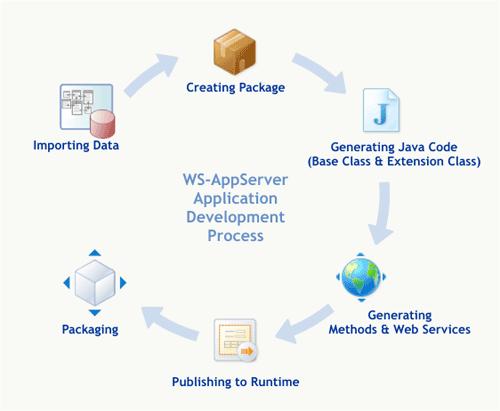Generating Application and Business Logic on Relational Data |
|
WS-AppServer provides a framework for rapidly developing and deploying applications. Applications developed using this framework can leverage all the features of Process Platform as well as the traditional application server. WS-AppServer includes a pre-defined set of functions such as database persistence management, inter-process communications, authorization, authentication, stability, scalability, transaction management, and performance management. It can also be used to extend the logic locked inside existing applications and to build composite applications. The logic that encompasses this functionality is exposed as a Web service and is versatile in its applicability when compared to the traditional applications.
WS-AppServer allows application developers to extend the logic of the database-generated models. The extended logic is automatically exposed as Web services, enabling easy remote access and composition in business process models.
WS-AppServer provides an easy and simple way to develop applications. It facilitates creation of containers (packages) to hold the database-generated logic. It provides a user-friendly interface to structure and store data. Support for automatic generation of Web service operations is an added advantage. WS-AppServer also lets you add custom business logic to the existing models.
The following illustration demonstrates the application logic generation process that takes place within WS-AppServer.

Generating application logic using WS-AppServer involves the following activities:
- Create a Database Metadata.
- Do one of the following:
- Create Web service Interface
- Attach the Web service Interface to the WS-AppServer Service
The following table highlights the features of WS-AppServer and the associated benefits.
Features |
Benefits |
|---|---|
Manages applications based on databases with the help of the WS-AppServer business logic abstraction layer. |
Segregate application logic and database layers. |
Supports all major database systems, such as SQL Server, Oracle, and MySQL. |
Greater flexibility in data management and application development. |
Exposes business objects from databases in the form of Web services and manages them through a comprehensive development tool. |
Easy management of business objects with the help of the development tool. |
Auto-generates and manages services, thus enabling transaction management, remote access, and Web service exposure. |
Faster and lighter application logic using pre-built logic abstraction layer. |
Integrates with Rules to enable building dynamic business logic, in addition to the static compiled business logic. |
Enhanced agility in business by managing dynamic business logic in the form of rules. |
Integrates with XForms to allow the Web services generated by WS-AppServer to be exposed to the user interface, and enables quicker development of end-to-end solutions. This separates the business logic from the presentation layer and attaches it to the business logic layer. |
Enhanced developer productivity by integrating X-Forms with WS-AppServer. |
Provides extensible business logic with the help of extension class. |
Generation of Java extension class, facilitating the addition of ready-made simple business logic in the form of Java code snippets. Flexibility to provide custom business object implementation, which helps developers transcend the limitations posed by the tool, and express richer business objects and logic. |
Supports tracking changes in business objects using events and event listeners, and plug additional business logic into them for advanced functions. |
Intelligently managed services help developers to focus on business logic building. |
Supports handling business objects that are composed of several database tables or non-database objects. |
Faster and efficient reuse of application services because business objects are wrapped as Web services. |
Delegates business logic in client-side applications to server-side through validation support. |
Smarter user interface. Thinner client applications because the entire logic is handled by WS-AppServer. |
Supports auditing database tables of the application. |
Transaction auditing helps in preserving critical information and analyzing it whenever required. |
Is easily configurable to be used in an embedded mode. |
Facility to embed WS-AppServer into applications, enabling rich server side functionality, where most of the standard services are auto managed. |
Is XML compliant to facilitate advanced techniques of data communication. |
Event-based 4GL type of programming through Java, providing great flexibility to plug enterprise-specific business logic into the application. |
Exposes business object transaction management as Web services, thus enabling SOA and SOA-based business process modeling. |
Dynamic management of enterprise business data using custom business logic. |
Note:
Even before you start generating the application and business logic, it is important to configure the WS-AppServer Service. An Administrator would have the required privileges to do so.